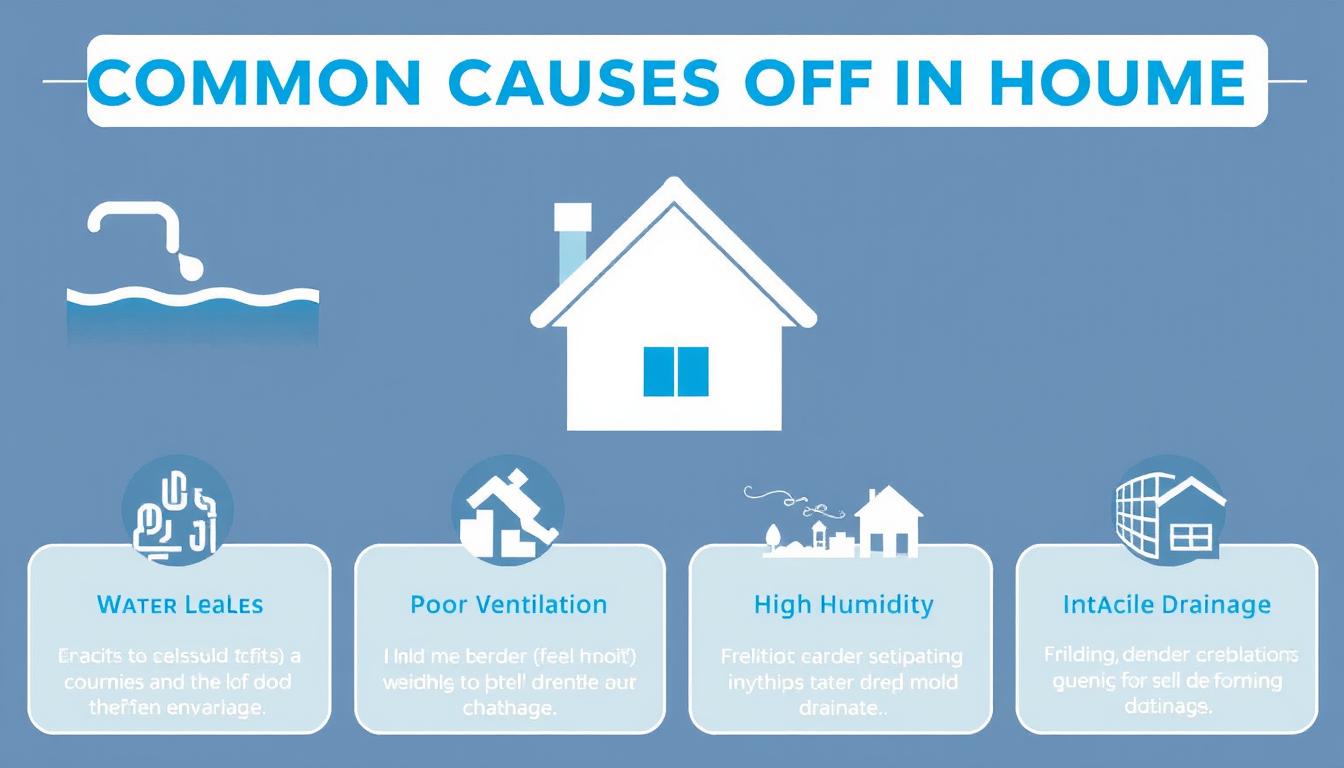According to the National Institute for Occupational Safety and Health, a staggering 47% of residential homes in the United States have visible mold or mold odor. For homebuyers, this statistic represents a significant risk that could turn your dream home into a health hazard and financial burden. A pre-purchase mold inspection for homeowners isn’t just another box to check—it’s an essential safeguard that could save you thousands in remediation costs and protect your family’s health.
While standard home inspections cover many structural and system issues, they typically don’t include comprehensive mold detection. This critical gap in the home-buying process leaves many new homeowners facing unexpected mold problems after closing. This guide will explain why dedicated mold inspections before purchase are non-negotiable and how they can prevent costly surprises down the road.
What Causes Mold in Homes You’re Looking to Buy
Understanding what causes mold growth is the first step in recognizing why a pre-purchase mold inspection for homeowners is so important. Mold thrives in specific conditions that are often hidden from plain sight during typical home viewings.
Common causes of mold growth that may not be visible during standard home tours
Primary Mold Growth Catalysts
- Undetected roof or plumbing leaks that may have been present for months
- Poor ventilation in bathrooms, kitchens, and basements
- Previous flooding events that weren’t properly remediated
- Condensation issues from improper insulation
- Persistent high humidity levels, especially in basements
- Inadequate drainage around the foundation
- Leaking HVAC systems that spread mold spores throughout the home
As experienced real estate agent Ed Kaminsky notes, “Every house has some type of mold, but it doesn’t necessarily mean it’s the ‘bad’ mold. Whether you’re buying or selling, there’s an education process you should go through about what type of mold it is.”
This education process begins with understanding that mold can develop within just 24-48 hours of a water intrusion event. A home that appears perfectly dry during your viewing may have hidden moisture issues that have been creating ideal conditions for mold growth behind walls, under floors, or in crawl spaces.
The Risks of Skipping a Pre-Purchase Mold Inspection
Many homebuyers focus on location, layout, and aesthetics while overlooking potential mold issues. This oversight can lead to significant consequences after closing. Understanding these risks highlights why a pre-purchase mold inspection for homeowners should be considered essential rather than optional.
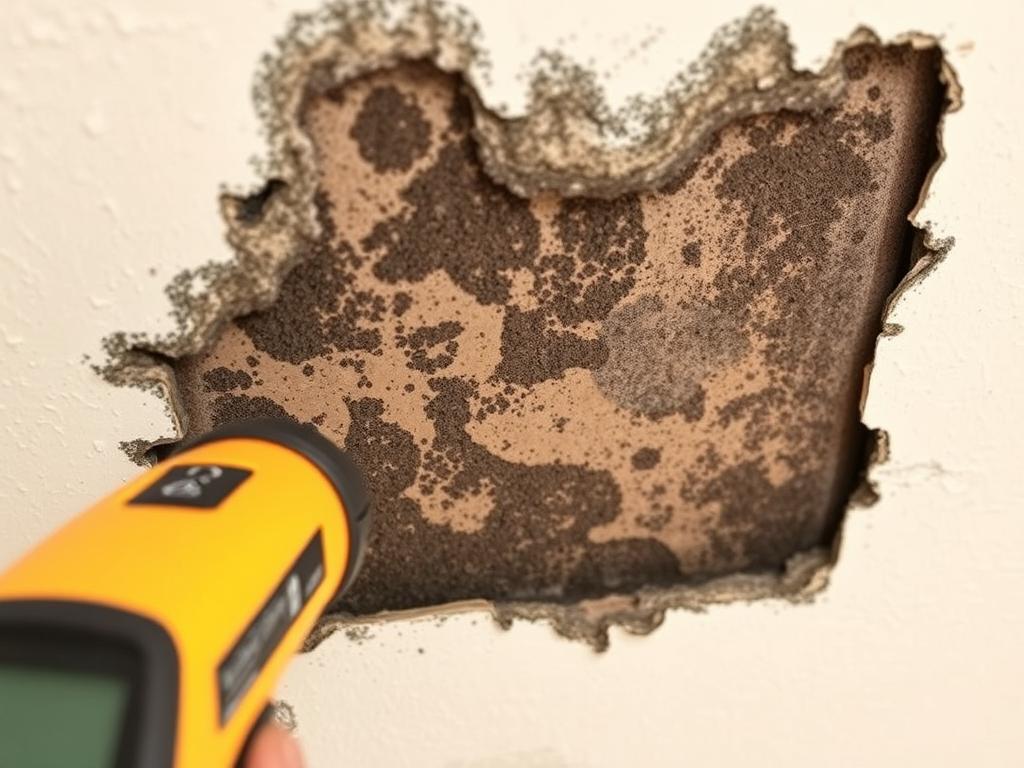
Hidden mold growth behind walls that would be missed in a standard home inspection
Financial Consequences
According to industry data, mold remediation typically costs between $1,150 and $3,400, but extensive cases can reach $20,000 or more. These unexpected expenses can devastate your budget shortly after making one of the largest investments of your life. Additionally, mold damage can devalue a home by 20-37%, representing a substantial loss on your investment.
Health Implications
The health risks associated with mold exposure range from mild allergic reactions to serious respiratory conditions. Common symptoms include:
- Nasal congestion and throat irritation
- Coughing and wheezing
- Eye irritation and skin rashes
- Headaches and fatigue
- Worsening of asthma or development of asthma-like symptoms
For vulnerable populations like children, elderly individuals, and those with compromised immune systems, these health effects can be even more severe and long-lasting.
Legal Complications
While sellers in many states are required to disclose known mold issues, the key word is “known.” If sellers aren’t aware of hidden mold, they have no obligation to disclose it. After closing, the principle of “caveat emptor” (buyer beware) often applies, leaving you with limited legal recourse for undisclosed mold problems.
Don’t Risk Your Investment and Health
Protect yourself from hidden mold issues before finalizing your home purchase. Connect with certified mold inspection professionals in your area today.
Mold Inspection vs. General Home Inspection
One common misconception among homebuyers is that a standard home inspection will identify mold issues. This misunderstanding can lead to false confidence and missed opportunities to detect serious mold problems before purchase.
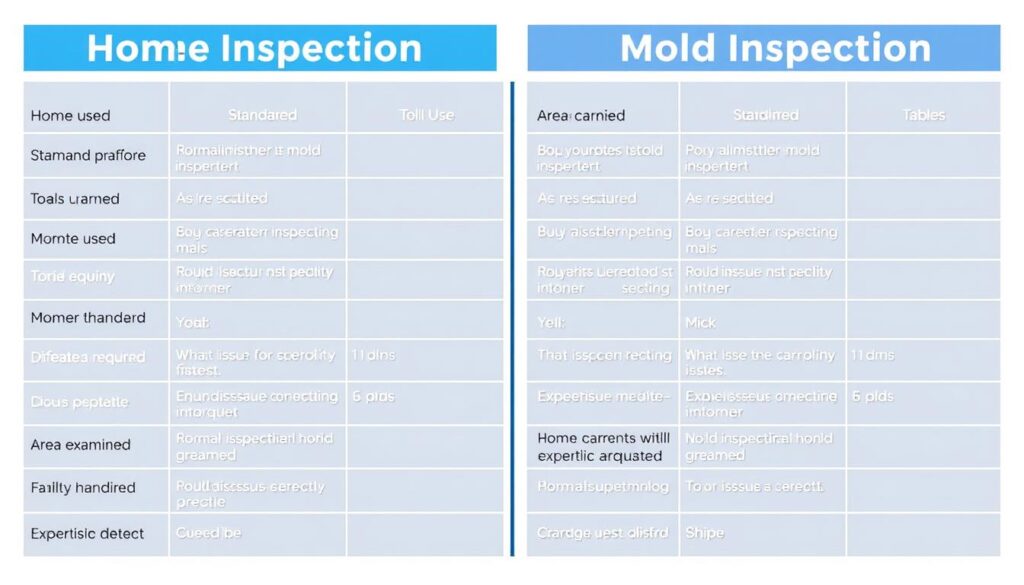
Key differences between standard home inspections and specialized mold inspections
As Bret Pfeifer, lead inspector at Golden State Mold Inspections, explains: “It is not a home inspector’s job to check for mold. Most will mention signs of water damage or potential mold issues if they come across it, but they won’t go out of their way to look for it.”
This distinction is crucial because mold growth often begins in areas that aren’t readily visible during a standard home inspection, such as inside walls, under flooring, or in crawl spaces. A dedicated mold inspection employs specialized tools and techniques specifically designed to detect these hidden problems.
| Aspect | Standard Home Inspection | Specialized Mold Inspection |
| Primary Focus | General structural and system integrity | Specific detection of mold and moisture issues |
| Tools Used | Basic visual inspection tools | Moisture meters, infrared cameras, air sampling equipment |
| Areas Examined | Accessible areas of the home | Includes hidden areas prone to mold growth |
| Sampling | No laboratory testing | Air and surface samples analyzed in a laboratory |
| Mold Identification | May note obvious visible mold | Identifies specific mold types and concentration levels |
| Remediation Guidance | Limited or none | Detailed recommendations based on findings |
Types of Mold Tests in Pre-Purchase Inspections
A comprehensive pre-purchase mold inspection for homeowners typically involves several testing methods to provide a complete picture of any existing or potential mold issues. Understanding these different testing approaches can help you ensure you’re getting a thorough assessment.
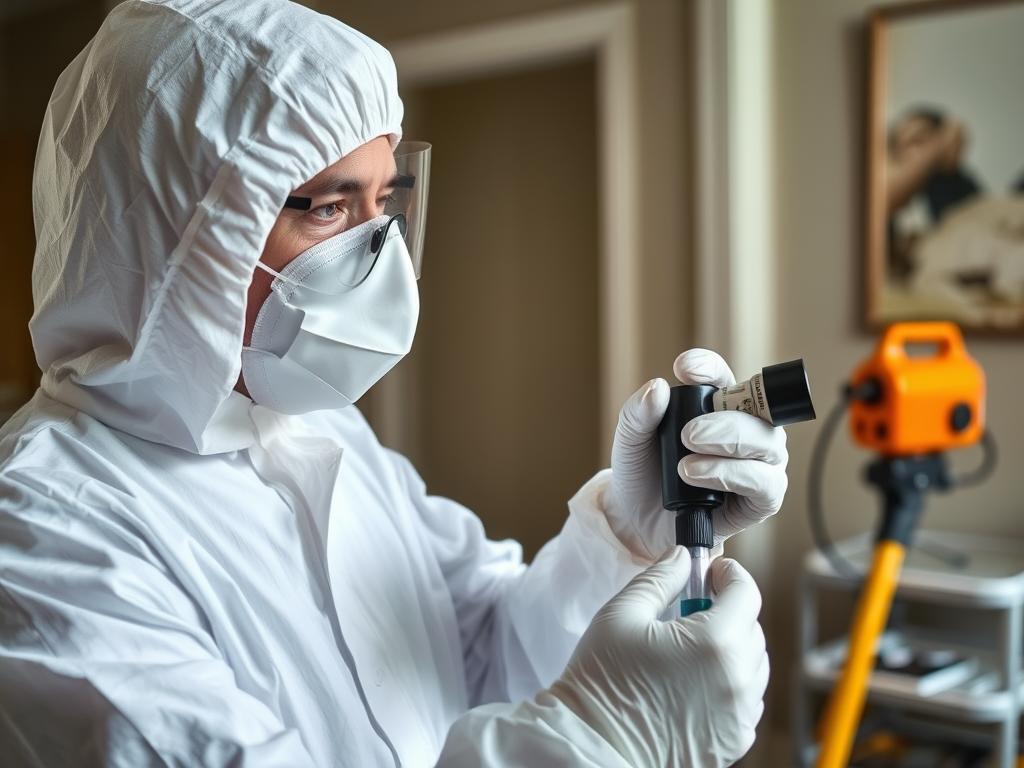
Professional mold inspector collecting air samples to detect airborne mold spores
Air Sampling
Air sampling is one of the most effective methods for detecting mold that isn’t visible to the naked eye. This process involves:
- Collecting air samples using specialized equipment
- Analyzing samples in a laboratory to identify mold types and concentrations
- Comparing indoor air samples with outdoor baseline samples
- Determining if mold spore levels are elevated and potentially harmful
Air sampling is particularly valuable for detecting mold that may be growing inside walls, HVAC systems, or other hidden areas where spores are released into the air.
Surface Sampling
When visible mold is present or suspected on specific surfaces, inspectors may collect samples using several techniques:
- Swab Testing: Using sterile swabs to collect samples from surfaces
- Tape Lift Sampling: Applying clear tape to lift mold from surfaces for analysis
- Bulk Sampling: Collecting small pieces of material (like drywall) for laboratory examination
Surface sampling helps identify the specific types of mold present and their concentration, which is crucial for developing an appropriate remediation plan if needed.
Moisture Mapping
While not a direct mold test, moisture mapping is an essential component of a thorough mold inspection. Inspectors use specialized tools to identify areas of elevated moisture that could support mold growth:
- Moisture Meters: Detect moisture levels in building materials
- Infrared Cameras: Identify temperature variations that may indicate moisture behind walls
- Hygrometers: Measure humidity levels in different areas of the home
By identifying moisture issues, inspectors can pinpoint areas at risk for current or future mold growth, even if mold isn’t yet visible or detectable through air sampling.
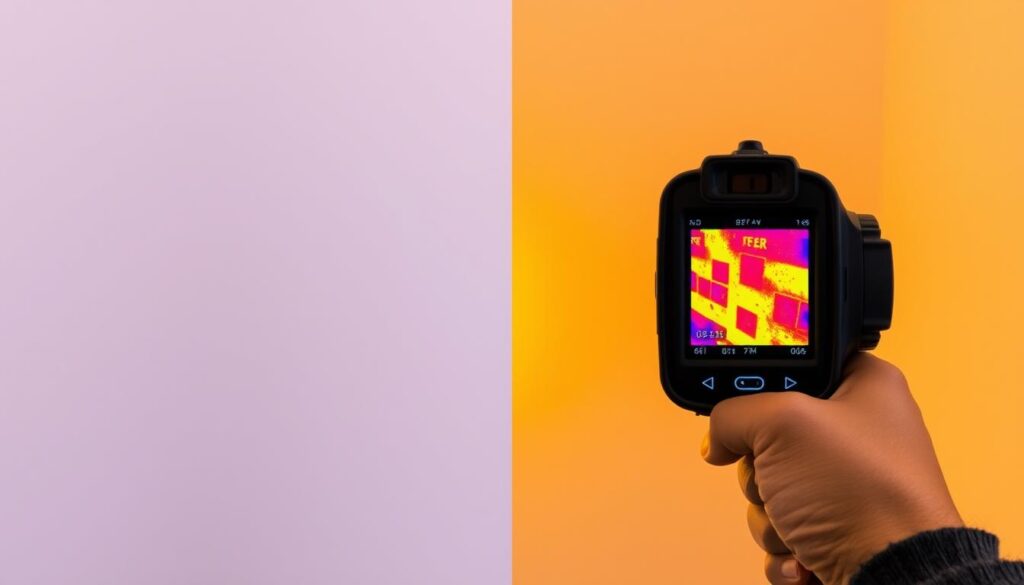
Infrared imaging revealing hidden moisture issues that could lead to mold growth
Cost-Benefit Analysis of Pre-Purchase Mold Inspections
When considering whether to invest in a pre-purchase mold inspection for homeowners, it’s important to weigh the upfront costs against the potential long-term benefits and savings.
Inspection Costs
According to industry data, the cost of a professional mold inspection typically ranges from $300 to $1,075, with the national average around $688. For homes under 4,000 square feet, expect to pay between $300 and $400, while larger homes may cost between $700 and $1,000 to inspect.
Several factors influence the final cost:
- Size of the property
- Accessibility of potential problem areas
- Number and types of samples needed
- Laboratory testing requirements
- Geographic location
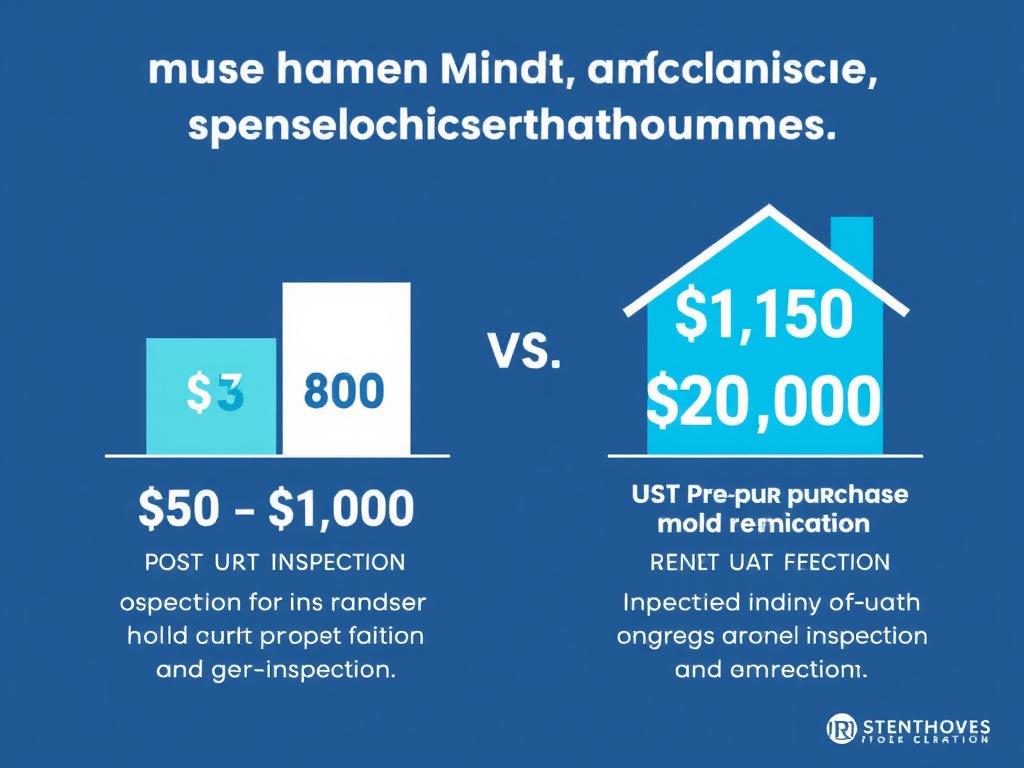
Cost comparison: Pre-purchase inspection vs. post-purchase remediation
Potential Savings
When compared to the potential costs of addressing undiscovered mold problems after purchase, the inspection fee represents a minimal investment:
Negotiation Leverage
Beyond the direct financial savings, a pre-purchase mold inspection provides valuable negotiation leverage if issues are discovered:
- Request that the seller complete remediation before closing
- Negotiate a reduction in purchase price to cover remediation costs
- Request a repair credit to address the issues after purchase
- Option to walk away from the purchase if significant problems are found
Protect Your Investment with Professional Inspection
A small investment now can save you thousands in unexpected remediation costs later. Get a free quote from certified mold inspection professionals in your area.
| Expense Category | Typical Cost Range | Potential Savings from Early Detection |
| Mold Remediation | $1,150 – $3,400 (up to $20,000 for severe cases) | $1,000 – $19,000+ |
| Structural Repairs | $500 – $10,000+ | Complete avoidance or negotiated seller repair |
| Medical Expenses | Varies widely | Prevention of health issues |
| Property Value Loss | 20-37% of home value | Preservation of investment value |
| Temporary Relocation | $1,000 – $3,000 per month | Complete avoidance |
Mold Prevalence Data: Why Inspection Matters
Recent data from government and academic sources underscores the widespread nature of mold issues in residential properties and highlights why pre-purchase mold inspection for homeowners is increasingly important.
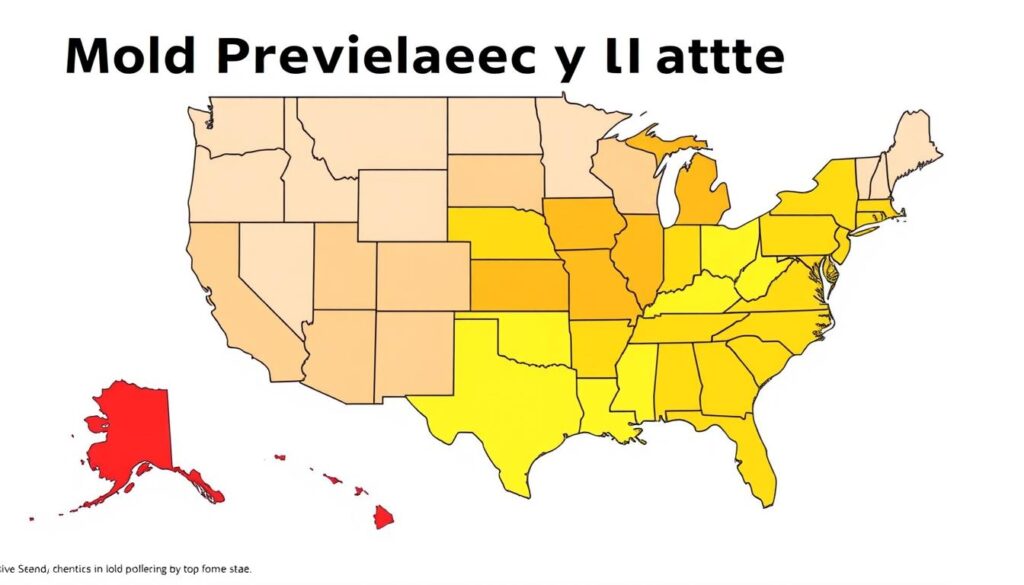
Mold prevalence across the United States (Data source: Look Mold, 2023)
National Statistics
According to the National Institute for Occupational Safety and Health, 47% of U.S. homes have visible mold or mold odor. The Environmental Protection Agency (EPA) reports that indoor air can be 2-5 times more polluted than outdoor air, with mold spores being a significant contributor to this pollution.
Regional Variations
Mold prevalence varies significantly by region, with certain states facing higher risks due to climate conditions:
Top 5 Moldiest States
- Florida
- Louisiana
- Texas
- Mississippi
- California
5 States with Lowest Mold Risk
- Nevada
- Utah
- Arizona
- New Mexico
- Minnesota
Additional research has identified Hawaii, Vermont, Wyoming, and North Dakota as having significant mold issues. These regional variations highlight the importance of understanding local mold risks when purchasing property.
Health Impact Data
The Centers for Disease Control and Prevention (CDC) has documented the health effects of mold exposure, noting that:
- People with asthma, allergies, or other breathing conditions may be more sensitive to mold
- Exposure to damp and moldy environments may cause nasal stuffiness, throat irritation, coughing, wheezing, eye irritation, or skin irritation
- Some studies have suggested a potential link between early mold exposure and the development of asthma in children
These statistics emphasize that mold issues are not rare occurrences but common problems that homebuyers should proactively address through proper inspection before purchase.
What to Expect During a Pre-Purchase Mold Inspection
Understanding the mold inspection process helps homebuyers know what to look for when hiring a professional and how to interpret the results they receive.
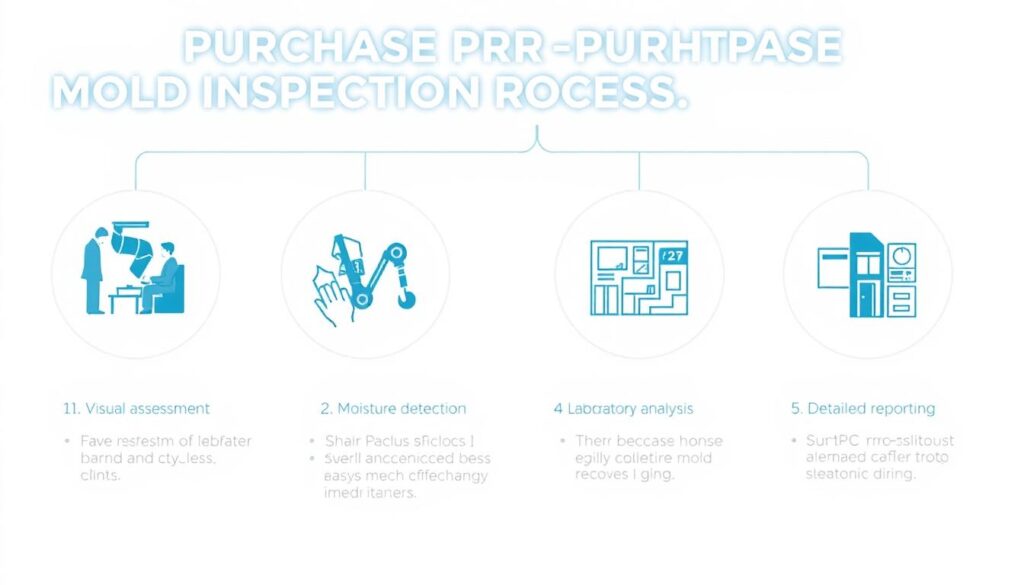
The five key steps in a comprehensive pre-purchase mold inspection
Initial Visual Assessment
The inspection begins with a thorough visual examination of the property, focusing on:
- Areas prone to moisture accumulation (bathrooms, kitchens, basements)
- Signs of water damage or previous leaks
- Visible mold growth or discoloration
- Musty odors that may indicate hidden mold
- Poor ventilation systems that could contribute to moisture problems
Moisture Detection
Using specialized equipment, inspectors identify areas with elevated moisture levels:
- Moisture meters to measure moisture content in building materials
- Infrared cameras to detect temperature variations indicating moisture behind walls
- Hygrometers to assess relative humidity levels throughout the home
Sample Collection
Based on the visual assessment and moisture readings, inspectors collect various samples:
- Air samples from multiple locations inside and outside the home
- Surface samples from areas with visible mold or suspected contamination
- Bulk samples of building materials if deeper contamination is suspected
Laboratory Analysis
Collected samples are sent to accredited laboratories where technicians:
- Identify specific mold species present
- Determine spore concentrations
- Assess whether levels exceed normal background levels
- Identify potentially toxic or allergenic mold varieties
Detailed Reporting
A comprehensive inspection concludes with a detailed report that typically includes:
- Documentation of all findings with photographs
- Laboratory results with interpretation
- Identification of moisture sources and problem areas
- Recommendations for remediation if needed
- Estimated scope and cost of necessary remediation
The entire inspection process typically takes 2-4 hours for the on-site portion, with laboratory results available within 2-5 days. This timeline allows homebuyers to receive results during the standard inspection contingency period in most real estate transactions.
How to Find a Qualified Mold Inspector
Selecting the right professional for your pre-purchase mold inspection for homeowners is crucial to ensuring accurate results and valuable guidance. Not all mold inspectors offer the same level of expertise or service.
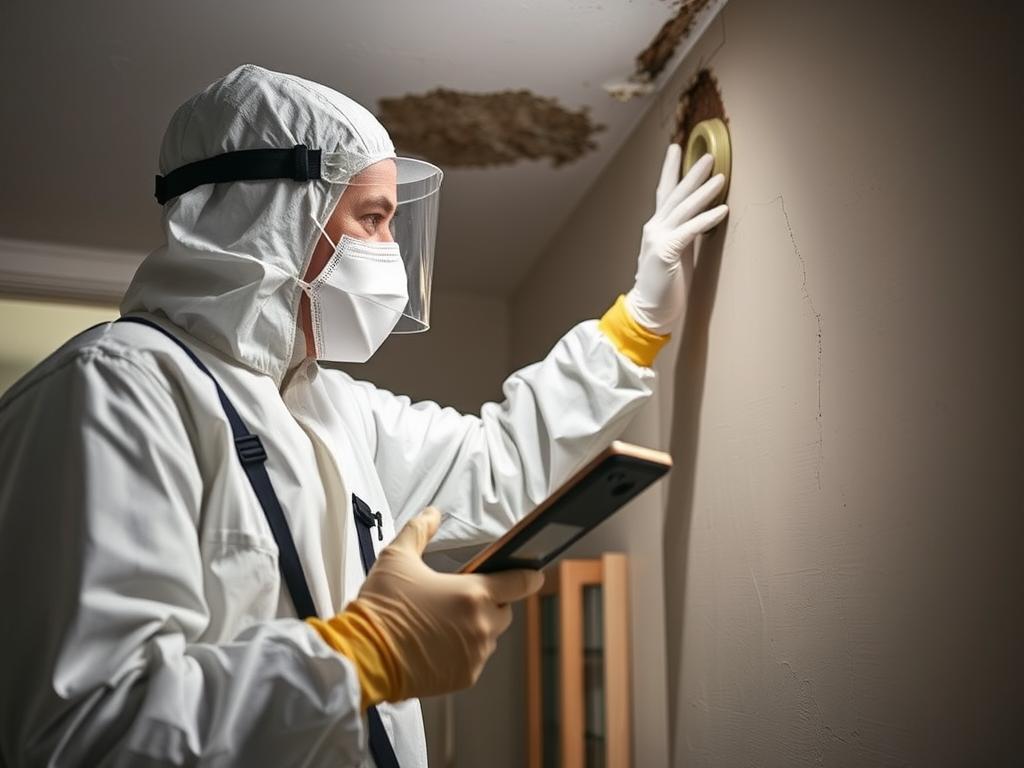
A certified mold inspector using specialized equipment during a home examination
Essential Qualifications
When searching for a mold inspector, look for these important credentials and qualifications:
- Certification: Certification from recognized organizations such as the National Association of Mold Professionals (NAMP), American Council for Accredited Certification (ACAC), or the Indoor Air Quality Association (IAQA)
- Licensing: Proper licensing in states that regulate mold assessment professionals
- Experience: Substantial experience specifically in residential mold inspection
- Independence: No financial connection to mold remediation companies to avoid conflicts of interest
- Insurance: Proper liability insurance and professional coverage
Red Flags to Avoid
Be wary of inspectors who exhibit these concerning practices:
- Offering both inspection and remediation services (potential conflict of interest)
- Providing estimates without proper sampling and testing
- Using scare tactics to pressure you into expensive services
- Lacking proper certification or licensing
- Unwillingness to explain their process or findings
Questions to Ask Potential Inspectors
Before hiring a mold inspector, ask these important questions:
- “What certifications and licenses do you hold?”
- “How many years have you been performing mold inspections?”
- “What specific testing methods do you use?”
- “Do you also provide remediation services?” (The answer should be no)
- “Which laboratories do you use for sample analysis?”
- “Can you provide references from recent clients?”
- “What does your inspection include and exclude?”
- “How long will the inspection take and when will results be available?”
As Bret Pfeifer from Golden State Mold Inspections warns: “It’s a known issue in the industry that homeowners are sometimes taken advantage of by unscrupulous mold remediation contractors or inspectors that have business arrangements with contractors. These bad apples will use scare tactics to recommend thousands of dollars in unnecessary work.”
Taking the time to find a qualified, independent mold inspector will ensure you receive accurate information about the property’s condition without unnecessary upselling or conflicts of interest.
Frequently Asked Questions About Pre-Purchase Mold Inspections
Can mold inspection be negotiated in home purchase?
Yes, mold inspection findings can be powerful negotiation tools in the home-buying process. If your pre-purchase mold inspection uncovers issues, you have several options:
- Request that the seller complete professional remediation before closing
- Negotiate a reduction in the purchase price to cover remediation costs
- Ask for a repair credit that allows you to address the issues after purchase
- Walk away from the purchase if the problems are severe and the seller is unwilling to negotiate
According to real estate experts, sellers are often willing to negotiate when presented with professional inspection findings, as they would likely face the same issues with future buyers if they don’t address them.
How long does a mold inspection take?
The duration of a mold inspection depends on several factors, including the size of the property and the extent of testing needed:
- On-site inspection: Typically 2-4 hours for an average-sized home
- Basic visual inspection: 1-2 hours
- Comprehensive inspection with extensive sampling: Up to 4-6 hours
- Laboratory analysis: 2-5 days for results after sample collection
Most inspectors can schedule the on-site portion within a few days of your request, making it feasible to complete the entire process within the standard inspection contingency period in most real estate transactions.
Does homeowners insurance cover mold inspection or remediation?
Homeowners insurance typically does not cover pre-purchase mold inspections. For existing homeowners, mold remediation coverage depends on the cause of the mold:
- Mold resulting from a covered peril (like a burst pipe) may be partially covered
- Mold from ongoing maintenance issues, high humidity, or flooding is typically excluded
- Many policies have specific mold exclusions or caps on mold-related coverage
For homebuyers, it’s best to consider the cost of a pre-purchase mold inspection as an investment in protecting your future home rather than an expense that might be covered by insurance.
Can I do my own mold inspection before buying a house?
While DIY mold test kits are available for under , they have significant limitations compared to professional inspections:
- They typically only test for the presence of mold, not the type or concentration
- They lack the specialized equipment needed to detect hidden mold
- They don’t include moisture detection to identify potential future problems
- Results may not be accepted by sellers for negotiation purposes
- They don’t include professional interpretation or remediation recommendations
For a major investment like a home purchase, a professional mold inspection provides far more comprehensive and reliable information than DIY testing.
What’s the difference between mold testing and mold inspection?
Mold testing and mold inspection are related but distinct services:
- Mold Testing: The specific process of collecting and analyzing samples to identify mold types and concentrations. Testing alone (such as air sampling) provides limited information without the context of a full inspection.
- Mold Inspection: A comprehensive assessment that includes visual examination, moisture detection, targeted sampling, and professional analysis of conditions. A proper inspection incorporates testing as one component of a more thorough evaluation.
Some home inspectors offer “mold testing” as an add-on service, but this is not equivalent to a dedicated mold inspection by a certified specialist. For pre-purchase decisions, a complete mold inspection provides much more valuable information than isolated testing.
Preventing Mold Issues in Your New Home
After completing a pre-purchase mold inspection for homeowners and addressing any existing issues, it’s important to implement preventive measures to keep your new home mold-free.

Installing proper ventilation is a key strategy for preventing mold growth
Essential Mold Prevention Strategies
- Control Moisture: Fix leaks promptly and dry wet areas within 24-48 hours
- Improve Ventilation: Use exhaust fans in bathrooms and kitchens; open windows when weather permits
- Monitor Humidity: Keep indoor humidity between 30-50% using dehumidifiers if necessary
- Proper Drainage: Ensure gutters direct water away from the foundation
- Regular Maintenance: Inspect and clean HVAC systems, including air ducts
- Use Mold-Resistant Products: Consider mold-resistant drywall, paint, and building materials for renovations
- Proper Insulation: Prevent condensation by properly insulating walls, windows, and pipes
Ongoing Monitoring
Even after a clean pre-purchase inspection, regular monitoring helps catch potential issues early:
- Conduct visual inspections of moisture-prone areas quarterly
- Use humidity monitors in basements and other vulnerable spaces
- Watch for early warning signs like musty odors or unexplained allergic reactions
- Consider periodic professional inspections, especially after water events
By implementing these preventive measures, you can protect your investment and ensure your new home remains a healthy environment for years to come.
Conclusion: Protecting Your Investment and Health
A pre-purchase mold inspection for homeowners is not just another item on your home-buying checklist—it’s an essential safeguard for what may be the largest investment of your life. The relatively modest cost of a professional inspection ($300-$1,000) pales in comparison to the potential expenses of remediation ($1,150-$20,000+) and the health risks associated with living in a mold-contaminated environment.
By understanding the importance of dedicated mold inspections, knowing what to look for in a qualified inspector, and being prepared to use inspection findings in your negotiations, you position yourself to make an informed decision about your purchase. Whether the inspection reveals a clean bill of health or identifies issues that need addressing, the knowledge gained empowers you to protect both your financial investment and your family’s wellbeing.
Remember that standard home inspections typically don’t include comprehensive mold assessment. Taking the extra step to arrange a specialized mold inspection could be one of the most important decisions you make in the home-buying process.
Protect Your Investment – Schedule a Pre-Purchase Mold Inspection Today
Don’t risk buying a home with hidden mold issues. Connect with certified mold inspection professionals in your area who can provide thorough assessment and peace of mind.
